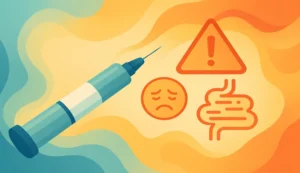Agoraphobia, a complex anxiety disorder, can significantly impact an individual’s daily life. In this blog, we’ll explore various aspects of agoraphobia, from its examples and distinctions to potential solutions for overcoming it.
Agoraphobia manifests in various ways, often presenting itself through specific examples. Understanding these instances is crucial for recognizing and addressing the condition effectively.
Discover the complexities of agoraphobia in our exploration of its examples and practical improvements. From real-life instances to solutions for a better tomorrow, let’s break down agoraphobia’s challenges and find a path toward understanding and overcoming this anxiety disorder.
Understanding Panic Disorder in the Absence of Agoraphobia:
Panic disorder, standing alone without the entwining presence of agoraphobia, unfolds as a distinct chapter in the narrative of anxiety. It is characterized by the abrupt onset of intense fear, often accompanied by palpitations, shortness of breath, and an overwhelming sense of impending doom. In this unique exploration, we strip away the layers to focus solely on panic disorder, dissecting its manifestations and triggers.
When agoraphobia is absent, it’s possible to examine the complex dynamics of panic disorder, comprehend how it affects day-to-day functioning, and identify possible coping and relief strategies.
Our aim as we set out on this concentrated trip is to learn more about the nature of panic disorder and provide a better understanding for individuals who are trying to manage and get past its unique challenges.
Agoraphobia as a Disability: Myth or Reality?
Agoraphobia, which is more than just a fear of open spaces, raises questions about whether it should be considered a disability.
This anxiety disorder brings about intense fear in situations where escape might be challenging, impacting daily life significantly. Even though you can’t see it, agoraphobia’s effects on everyday activities are real, challenging the idea that it’s not a genuine disability.
Breaking Down Myths and Embracing Reality:
Some argue that agoraphobia isn’t a “real” disability because it lacks visible signs. But the truth is, it can be profoundly disabling. From difficulties in attending social events to everyday tasks becoming a challenge, acknowledging these struggles is essential.
Recognizing agoraphobia as a legitimate disability opens the door to better understanding and support, fostering a more inclusive society that embraces the diverse challenges individuals face.
Is It Possible to Treat Agoraphobia? Interpreting the Preventible Challenge.
Agoraphobia, a form of anxiety disorder, often leaves individuals grappling with the question of whether treatment is a viable option. The complexities of agoraphobia extend beyond mere fear of open spaces, impacting daily life and hindering normal activities.
Is It Possible to Treat Agoraphobia?
Addressing the possibility of treating agoraphobia is essential, as it offers hope and encouragement to those affected by this condition.
While complete eradication may not always be attainable, significant progress can be made with the right therapeutic approaches.
Cognitive-behavioral therapy (CBT), exposure therapy, and medication are among the commonly employed methods, aiming to alleviate symptoms and empower individuals to regain control over their lives. The effectiveness of treatment can vary, but many individuals find relief and improved functioning through tailored interventions.
Interpreting the Preventable Challenge:
Interpreting agoraphobia as a preventable challenge involves recognizing the factors that contribute to its development and exacerbation. Early intervention, education, and destigmatization play pivotal roles in prevention. By fostering an environment that promotes mental health awareness and understanding, we can work towards reducing the occurrence and severity of agoraphobia.
Prevention also extends to creating supportive structures for those affected, emphasizing the importance of accessible mental health resources, community understanding, and compassionate care. In interpreting agoraphobia as a preventable challenge, we shift the focus towards proactive measures that can positively impact individuals and communities.
Social Anxiety vs. Agoraphobia: Bridging the Gap:
In the spectrum of anxiety disorders, social anxiety, and agoraphobia represent distinct but impactful challenges, each characterized by unique features that significantly influence an individual’s daily life. Bridging the gap between these two conditions requires a comprehensive understanding of their nuances, triggers, and manifestations.
Social Anxiety:
Social anxiety, also known as social phobia, is marked by an intense fear of social situations and the potential scrutiny or judgment by others.
Individuals with social anxiety often experience overwhelming anxiety in situations such as public speaking, meeting new people, or participating in social gatherings. The fear of negative evaluation can lead to avoidance behaviors, impacting personal relationships, academic or professional performance, and overall quality of life.
Agoraphobia:
On the other hand, agoraphobia is characterized by a fear of situations where escape might be challenging or help unavailable. Contrary to social anxiety, agoraphobia is not limited to social scenarios but extends to various environments, such as crowded spaces, public transportation, or open areas.
Individuals with agoraphobia may avoid these situations due to the fear of experiencing panic attacks or being unable to escape, leading to isolation and a restricted lifestyle.
Bridging the Gap:
While social anxiety and agoraphobia manifest differently, there can be an overlap, especially in avoidance behaviors. Individuals with social anxiety might develop agoraphobic tendencies, avoiding situations where social interactions are likely to occur. Understanding the commonalities and distinctions between these disorders is crucial for accurate diagnosis and effective treatment planning.
Treatment Approaches:
Both social anxiety and agoraphobia are treatable conditions. Cognitive-behavioral therapy (CBT), exposure therapy, and medication are common therapeutic approaches used to address these disorders.
In CBT, individuals learn to challenge and reframe negative thought patterns, while exposure therapy involves gradually facing and overcoming feared situations. Medications, such as selective serotonin reuptake inhibitors (SSRIs), may also be prescribed to alleviate symptoms.
Agoraphobia in Children: Recognizing and Supporting:
Agoraphobia, typically associated with adults, can also affect children, presenting unique challenges for both identification and support. Recognizing the signs of agoraphobia in children is essential for early intervention and fostering a supportive environment.
This exploration aims to shed light on the manifestation of agoraphobia in children, offering insights into recognizing symptoms and providing the necessary support for their mental well-being.
Recognizing Agoraphobia in Children:
Identifying agoraphobia in children requires a keen awareness of behavioral patterns and emotional cues. Children with agoraphobia may exhibit excessive fear or distress in situations perceived as difficult to escape, leading to avoidance behaviors.
This might include reluctance to attend school, participate in social activities, or venture beyond familiar environments. Unexplained physical symptoms such as headaches or stomachaches may also be indicative of underlying anxiety.
Causes and Triggers:
Understanding potential causes and triggers is crucial in recognizing agoraphobia in children. Traumatic events, major life changes, or a predisposition to anxiety disorders can contribute to the development of agoraphobic tendencies. Identifying these factors enables caregivers and educators to provide targeted support and interventions tailored to the child’s needs.
Supporting Children with Agoraphobia:
Support for children with agoraphobia involves creating a nurturing environment that acknowledges their challenges and encourages gradual exposure to feared situations. Open communication with caregivers, teachers, and mental health professionals is essential in developing a comprehensive support plan. Educators can play a vital role by implementing strategies that accommodate the child’s needs, fostering a sense of security within the school environment.
Professional Intervention:
In cases where agoraphobia significantly impacts a child’s daily life, seeking professional intervention is crucial. Mental health professionals like child psychologists or therapists can conduct assessments and provide evidence-based interventions. Cognitive-behavioral therapy (CBT) tailored for children is often effective in addressing agoraphobic symptoms and equipping them with coping strategies.
Professional Help:
In cases significantly impacting a child’s life, seeking professional intervention, like cognitive-behavioral therapy (CBT) from child psychologists, is crucial. CBT tailored for children is effective in addressing agoraphobic symptoms and teaching coping strategies.
Parental and Educational Collaboration:
Collaboration between parents, caregivers, and educators is key. Regular communication ensures a consistent approach across home and school. Parental involvement in therapy enhances effectiveness and strengthens the child’s support system.
Overcoming Agoraphobia: A Fast-Track Guide
For those seeking practical solutions, we’ll provide a fast-track guide on how to overcome agoraphobia. From gradual exposure techniques to therapeutic interventions, this section aims to empower individuals on their journey to recovery. This fast-track guide provides key insights to help you navigate this process efficiently.
1. Acknowledge Your Feelings:
The first step is acknowledging your feelings without judgment. Understand that agoraphobia is a real challenge, and it’s okay to seek support.
2. Start Small:
Begin by exposing yourself to manageable situations that trigger anxiety. Gradual exposure helps build confidence and resilience over time.
3. Set Achievable Goals:
Establish realistic goals for yourself. Celebrate small victories, as they contribute to the overall progress in overcoming agoraphobia.
4. Seek Professional Help:
Consider reaching out to mental health professionals specializing in anxiety disorders. Therapies like Cognitive-Behavioral Therapy (CBT) can be particularly effective.
5. Involve Supportive Individuals:
Share your journey with friends, family, or support groups. Having a reliable support system can provide encouragement and motivation.
6. Practice Relaxation Techniques:
Incorporate relaxation techniques, such as deep breathing or mindfulness, to manage anxiety levels in challenging situations.
7. Gradually Expand Your Comfort Zone:
As you gain confidence, gradually expand your comfort zone. This may involve tackling more complex situations or environments.
8. Celebrate Progress:
Celebrate each step forward, no matter how small. Positive reinforcement contributes significantly to the process of overcoming agoraphobia.
Panic Disorder vs. Agoraphobia: Spotting the Variations:
In the world of anxiety, panic attacks and feeling trapped (agoraphobia) play different roles. We’ll revisit the relationship between panic disorder and agoraphobia, emphasizing the importance of accurate diagnosis for tailored treatment plans.
Panic Attacks: Unexpected Storms:
Panic attacks are like sudden storms of fear. Your heart races, breathing gets fast, and it feels like something terrible is about to happen. They hit you out of the blue, leaving you shaken and anxious.
Feeling Trapped: Agoraphobia’s Response:
Agoraphobia is how some people react to panic attacks. It’s like feeling trapped – avoiding places or situations because you’re scared another panic attack might strike. It’s a way of trying to stay safe by steering clear of what seems threatening.
Finding the Clues:
To understand the difference, notice when the fear hits. If it’s out of nowhere, it’s likely a panic attack. If it’s in specific places or situations, agoraphobia might be at play. Spotting these clues is like having a map for better mental health.
Conclusion:
Agoraphobia is a complex condition, but with understanding, support, and appropriate interventions, individuals can navigate through its challenges. This blog aims to serve as a comprehensive guide, offering insights into agoraphobia’s various facets and empowering those on the path to recovery.
From understanding panic disorder without agoraphobia to contemplating its implications as a potential disability, we’ve navigated the complexities of this anxiety disorder.






